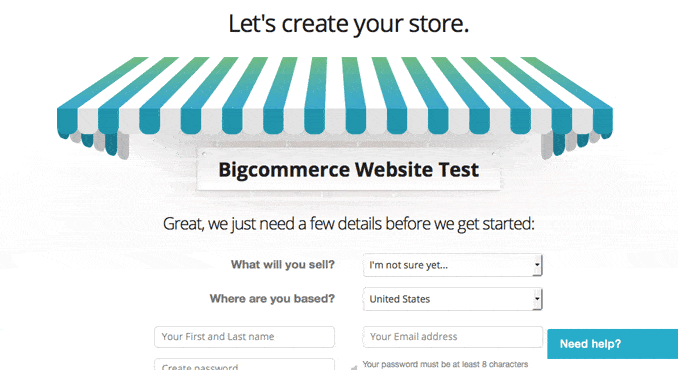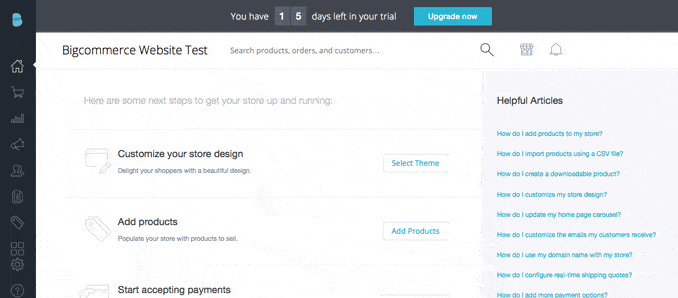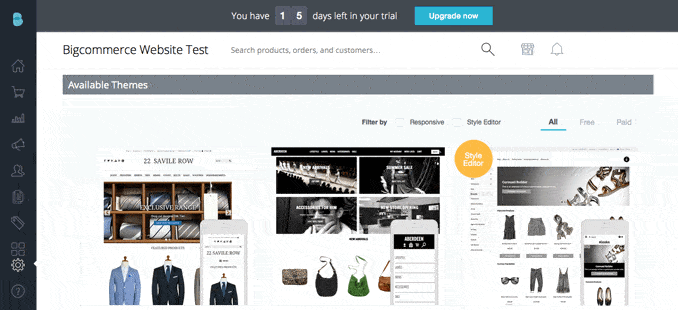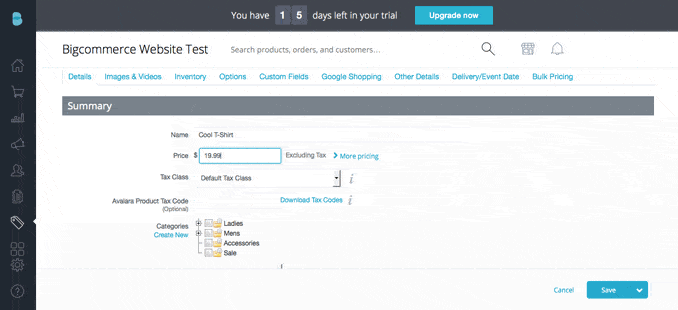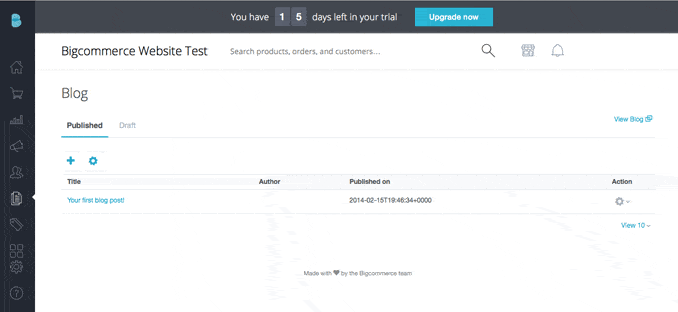Contents
BigCommerce Review: Every option an online store needs, wrapped up in one simple package
If we had to guess who was behind the eCommerce platform BigCommerce, we’d say it’s a team of veteran online store owners, that, or perhaps a cross between a ninja and a fairy godmother.
All jokes aside, BigCommerce has the most usable store options that we’ve seen so far. It only makes sense for users to have the option to add gift wrapping, bulk pricing and color swatches, but most platforms leave that out. Toss in a system that’s simple to use and yet pretty versatile, and you have a winning combination.
BigCommerce is designed specifically for selling online (business owners looking for a content-only website or blog should look elsewhere). That targeted focus and a solid understand of the needs of eCommerce store owners leads to a platform with a whole lot of pros and very few cons.
Getting Started with BigCommerce
After providing basic details like the store name, email and phone number, new users are taken to the dashboard. A quick pop-up guide introduces the navigation options at the left and top of the screen. For new users, the majority of the dashboard is taken up by a step-by-step guide to getting your store live.
BigCommerce is mostly a field-based editor, where users fill out fields or options to create their website. Unlike other similar platforms, however, there’s also an editing mode under settings that allows users to preview the site and drag and drop objects to change the design. While not as versatile or well-developed as other WYSIWYG (What You See Is What You Get) editors, having both options is unheard of. Most of the changes, however, are made simply by filling out options—leaving the business owner to work the business and the professionals behind the templates to take care of the design.
Choosing the theme is the first step in the guide, though it appears the design can be changed at any time without having to redo any content. BigCommerce has a wide range of paid templates, but at the time of our review, only about 15 free themes to choose from. Regardless, everything has a clean, modern design. Once the theme is selected, the style option at the top of that same page allows users to adjust colors and fonts. There’s even an option for adding HTML code.
Adding Products to BigCommerce
Of course, eCommerce is what BigCommerce is all about—so how do they stack up in the world of online retail? BigCommerce has the most product options we’ve seen so far, but all organized under tabs and headings so it doesn’t appear to be too overwhelming for new users. The first tab organizes all the essentials like the product name, price, description and category. The program indicates which field is required, so users won’t find all the options intimidating, since most can be left blank. When a user leaves an element blank that could affect the function of their store, a pop-up window alerts them—for example, if users do not input dimensions, they may not be able to get accurate shipping estimates.
Along with the basic first tab, there’s a second one dedicated entirely to adding photos and video and another where users can choose to track or not track their inventory. While it’s common to see a place to add options to a product like size, BigCommerce seems to have more possible options than most.
Have multiple color options? Users can add a swatch using a color number or RGB values, allowing customers to preview the color instead of choosing “red.” Custom fields are also available for creating a list of elements like ISBNs and release dates.
Customers can leave a note to the seller, such as customization options, with configurable fields. BigCommerce continues to offer the most options by allowing integration with Google Shopping (requires an upgraded subscription), along with options like gift wrap and bulk pricing that few platforms seem to offer.
Some of these options could be added in with customizable fields in other web builders, but options that affect the price are harder if not impossible to mimic. And if the options aren’t there, there’s a pretty wide range of apps that can expand the store even further. Back to the dashboard, new users only need to turn on Stripe to accept credit cards, choose shipping and taxes options and then can choose to launch the store.
Adding Pages and Blogs to BigCommerce
The storefront is clearly the focus of the BigCommerce platform, but adding pages and even a blog isn’t out of the question. Most themes already include basic about and contact pages that just need to be customized with the store’s information.
Users can add blank pages as well. Adding and adjusting new pages is done in a window that looks a lot like a Microsoft Word document—this is a bit more limited than a drag-and-drop style page editor, but at least wins points for keeping it simple.
A blog can be easily added to the storefront as well, either from an existing blog platform or directly on the site itself. Users can add an existing blog by creating a new page, then selecting the RSS feed option at the top. Posts can be added right to the website as well, which is a good marketing tool, under the blog option. Much like creating a WordPress post, users just need to fill out the title and body, as well as options like author, keyword and SEO details—like the rest of the site, adding a blog is quite simple.
Final Verdict – BigCommerce Review
BigCommerce has the most store options we’ve seen so far, yet even with all the expanded options, is still pretty easy to use. From gift wrap options to gift certificates, if you want it for your online store, chances are, BigCommerce has it. Since users just fill in fields, it’s fairly easy to use, though there’s even a drag and drop style editor if you’d like to adjust the template a bit.
When users do get stuck, a help center is readily available with tutorials, an online chat or an email for further assistance. We didn’t have any complex questions after building our test site, so we emailed the help desk with a basic question—they responded with a link to an article and an invitation to ask further questions if needed within ten minutes. Now that’s fast.
The basic Silver BigCommerce package is about $30 a month and should suit most small businesses—where most charge extra for options like coupons and gift certificates, they’re included in the basic package here. The Gold package sits at about $80 and the Platinum at $200, both with unlimited storage and extra features like emailing customers about abandoned shopping carts.
BigCommerce do not charge additional transaction fees on any of their plans (these fees were removed in December 2015). BigCommerce is not for developing a content-only website or just a blog, but it’s an excellent fit for users who want a store and perhaps a few pages and a blog to go with it. It’s by far the most full-featured platform we’ve tried, yet the number of options doesn’t seem to be overwhelming, thanks to the platform’s design.
If you want to start an online store today, we highly recommend using BigCommerce.
